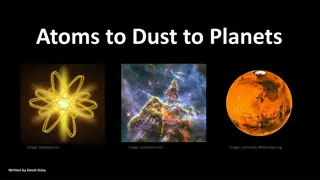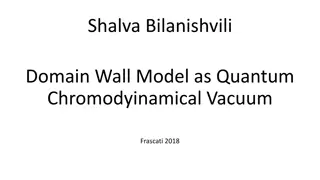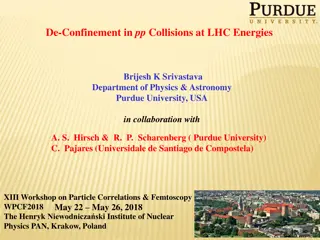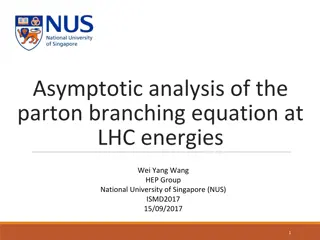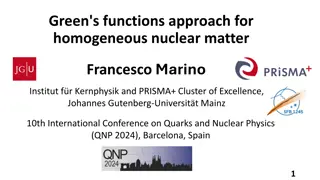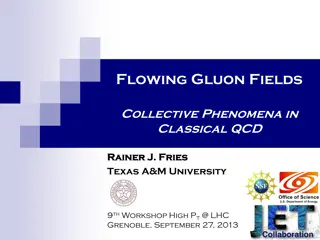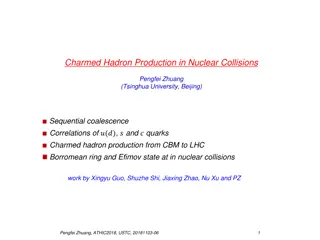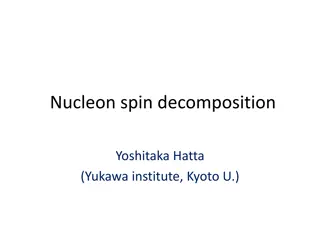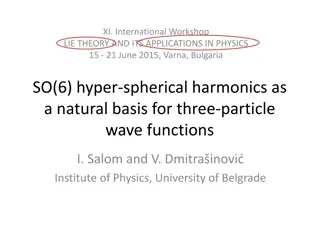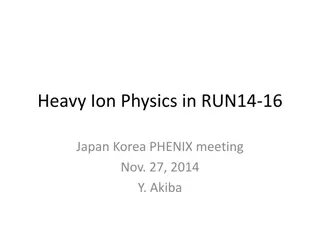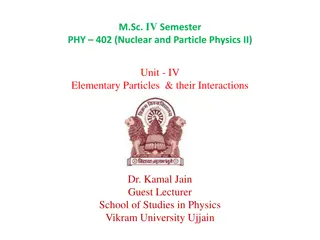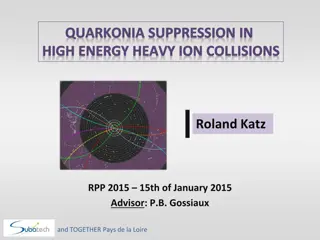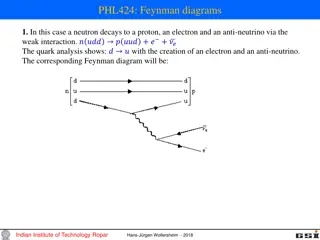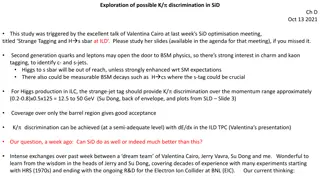The Journey of Atoms: From Big Bang to Supernovas
The evolution of atoms, from the creation of quarks and electrons in the Big Bang to the fusion of elements in stars and their explosive dissemination as supernovas, highlights the remarkable process of atom formation and distribution in the universe. Witness the transformation from subatomic partic
1 views • 32 slides
Quantum Chromodynamics and Effective Potential in Vacuum Physics
Delve into the intricacies of Quantum Chromodynamics and the concept of effective potential in the context of vacuum physics. Discover how quarks, leptons, photons, W and Z bosons, gluons, and the Higgs boson play crucial roles in shaping the fundamental structures of the quantum vacuum. Explore the
2 views • 11 slides
Insight into De-Confinement in High-Energy Nuclear Collisions
Explore the phenomena of de-confinement and clustering of color sources in nuclear collisions, revealing the transition to a state where quarks and gluons cannot be confined into color-neutral hadrons. This study delves into the relationship between percolation theory and de-confinement, shedding li
1 views • 34 slides
Insights into Parton Branching Equation at LHC Energies
Multiplicity distributions play a crucial role in understanding the cascade of quarks and gluons at the LHC energies, revealing underlying correlations in particle production. Popular models like Monte Carlo and statistical models are used to describe the charged particle multiplicity distributions.
1 views • 17 slides
Advanced Studies on Nuclear Matter Using Green's Functions Approach
Francesco Marino presents research on the Green's functions approach for homogeneous nuclear matter at the 10th International Conference on Quarks and Nuclear Physics. The ab initio approach in nuclear theory, self-consistent Green's functions, and algebraic diagrammatic construction are explored. P
0 views • 26 slides
Flowing Gluon Fields and Color Glass Phenomena in QCD
Explore the collective phenomena of gluon fields in classical QCD, focusing on the Standard Model of URHICs, Color Glass, and Gluon Fields in the Forward Lightcone. The research delves into topics like local thermal equilibrium, viscous hydrodynamics, and the interaction of probes with quarks and gl
0 views • 24 slides
Sequential Coalescence Model in Charmed Hadron Production
Research by Pengfei Zhuang explores the sequential coalescence correlations of charmed quarks leading to hadron production in nuclear collisions. The model involves sequential production temperature determination, QGP evolution time calculation, and coalescence process, shedding light on hadronizati
1 views • 17 slides
Nucleon Spin Decomposition and Proton Spin Problem
Explore the complex realm of nucleon spin decomposition and the enigmatic proton spin problem, delving into concepts like orbital angular momentum, quarks and gluons' helicity, and longitudinal double spin asymmetry in polarized deep inelastic scattering. Learn about the spin crisis, gluon polarizat
0 views • 26 slides
Applications of Hyper-Spherical Harmonics in Physics
Explore the utility of hyper-spherical harmonics as a natural basis for solving three-particle wave functions in physics, specifically in areas such as atomic physics, molecular physics, and systems involving three quarks. Learn about their role in reducing the complexity of problems, providing mani
0 views • 28 slides
Heavy Ion Physics at RHIC: RUN14-16 Overview
Exploring heavy ion physics at RHIC through the RUN14-16 campaigns, focusing on measuring heavy quarks like charm and bottom, the experimental setups, beam energies, and the significance of probing Quark Gluon Plasma using heavy quarks. Detailed information about the runs, detectors used, and the ma
0 views • 19 slides
Elementary Particles and Their Interactions in Nuclear and Particle Physics
Delve into the fascinating world of elementary particles, where quarks form the basis of protons and neutrons in the nucleus, alongside electrons. Discover a diverse array of particles such as muons, neutrinos, and quarks, each with unique properties of charge and mass. Uncover the significance of t
0 views • 10 slides
Quarkonia Suppression in High Energy Heavy Ion Collisions by Roland Katz
Investigating the phenomenon of Quarkonia suppression in high energy heavy ion collisions, Roland Katz explores the properties of Quark Gluon Plasma and the behavior of quarks and gluons under extreme conditions. The study delves into the dynamics using the Schrödinger-Langevin equation, highlighti
0 views • 23 slides
Feynman Diagrams in Particle Physics
Exploring the concept of Feynman diagrams in particle physics through various examples, such as the decay of particles like neutrons, protons, electrons, anti-neutrinos, pi-mesons, and more. The diagrams illustrate the interactions between quarks and leptons, showcasing the transformations and decay
0 views • 14 slides
Structure of the Atom: Properties and Components
The fundamental structure of atoms, exploring the composition of protons, neutrons, and electrons within the nucleus. Learn about the electron cloud model, the arrangement of electrons, and the scientific shorthand for identifying elements based on their symbols. Understand the significance of quark
0 views • 19 slides
Hadronization in JETSCAPE
In the JETSCAPE Workshop 2019, various hadronization models were explored, including independent fragmentation, string fragmentation, hybrid recombination, and quark recombination. The event delved into colorless and colored hadronization schemes within the framework, discussing processes like pairi
0 views • 28 slides
Main features of the hadronic dark matter scenario
In this scenario presented by V. Kuksa and V. Beylin from Southern Federal University, various aspects of new quarks, fundamental interactions, heavy quark evolution, and quantum numbers of heavy hadrons are discussed. The presentation delves into the definition of mass of new quarks, effective inte
0 views • 22 slides
Quark Sivers Function and Spin-Dependent Odderon: Insights from Small-?
Quark Sivers function and spin-dependent Odderon play crucial roles in understanding the three-dimensional structure of hadrons and the asymmetries observed in high-energy scattering processes. Ongoing efforts are focused on determining the small-? asymptotics of these functions and their contributi
0 views • 17 slides
Challenges in Searching for DD* Dimesons
The search for DD* dimesons involves analyzing effective quark-quark interactions, exploring production mechanisms, and understanding the formation of double-charm baryons. Challenges lie in dressing quarks, optimizing production in colliders, and speculating on fragmentation processes. The potentia
0 views • 12 slides
Double Cabibbo-Suppressed Decay in Charm Quarks
First discovery of double Cabibbo-suppressed decay in charm quarks, observed in D mesons, with significant signal observed in experiments like FOCUS and Belle. The weak decay amplitude reflects the structure and decay dynamics, challenging naive expectations. Analysis strategies involve precise bran
0 views • 22 slides
Non-Perturbative Effects on Heavy Quark Radiative Energy Loss
This study delves into non-perturbative effects impacting the radiative energy loss of heavy quarks, exploring their implications in strongly coupled QGP and high-energy parton interactions. The research presents a T-matrix approach for energy loss and investigates various scenarios with different n
0 views • 25 slides
Emergence of Hadron Mass at CERN's AMBER Experiment
Explore the physics program at CERN's AMBER experiment, investigating the nature of hadrons and the fundamental particles of quantum chromodynamics. Discover the questions surrounding hadron mass and the mechanisms of quarks and gluons in forming stable structures. Join the AMBER collaboration in un
0 views • 9 slides
Understanding Quarks, Leptons, and Particle Interactions
Explore the world of subatomic particles with topics ranging from quarks and leptons to Feynman diagrams and conservation laws. Dive into the differences between hadrons and leptons, understand the properties of quarks, and discover the intricacies of beta decay and particle interactions.
0 views • 13 slides
Comprehensive Analysis of Charm and Kaon Tagging for BSM Physics at SiD Ch.D Oct 13, 2021
Explore the potential discrimination of K/ in SiD Ch.D with a focus on strange tagging and Higgs decays to s and sbar. Insights from Valentina Cairo's presentation and discussions with experts reveal the importance of charm and kaon tagging for identifying c- and s-jets in second-generation quarks a
0 views • 6 slides
